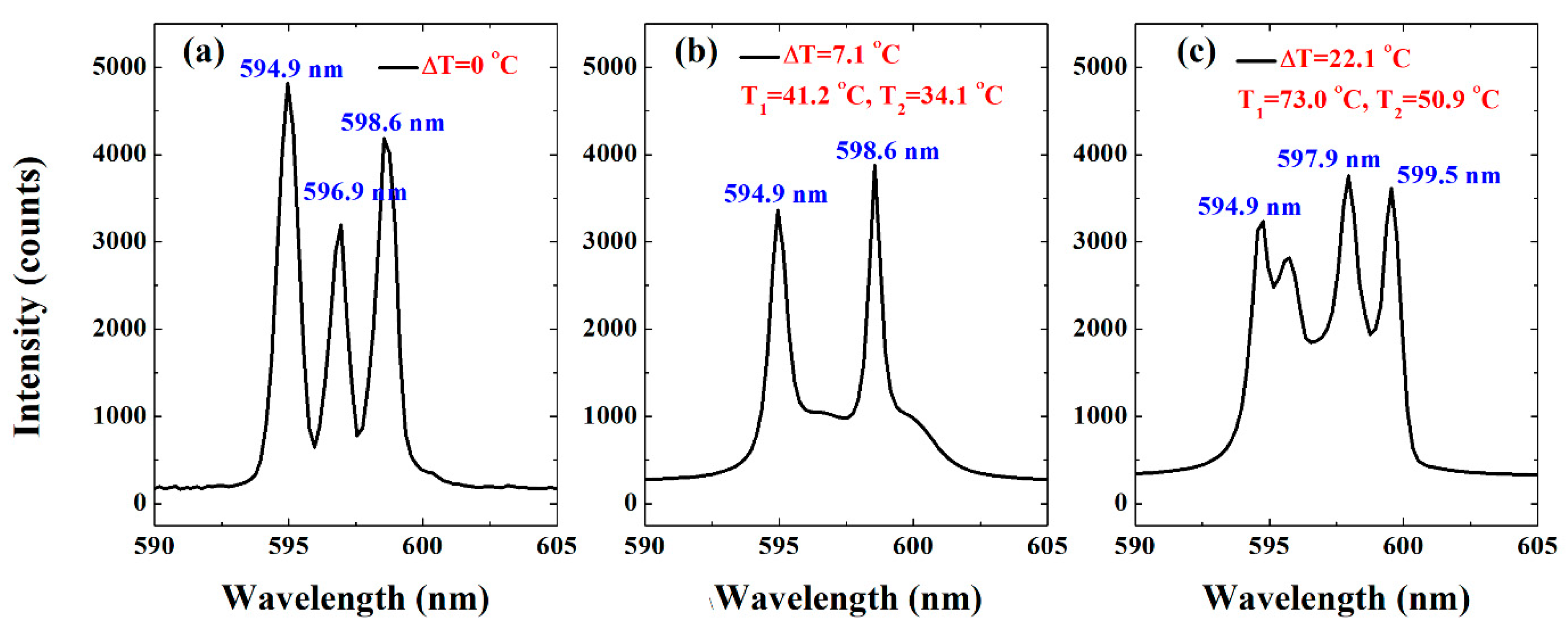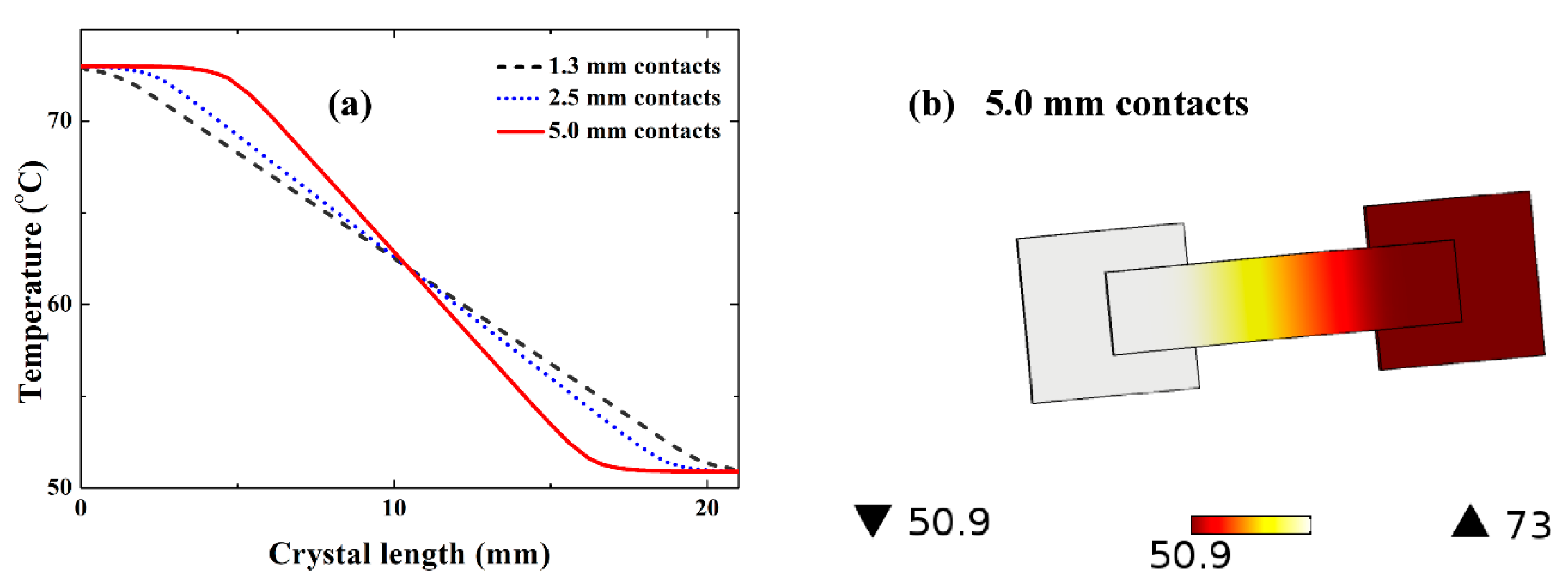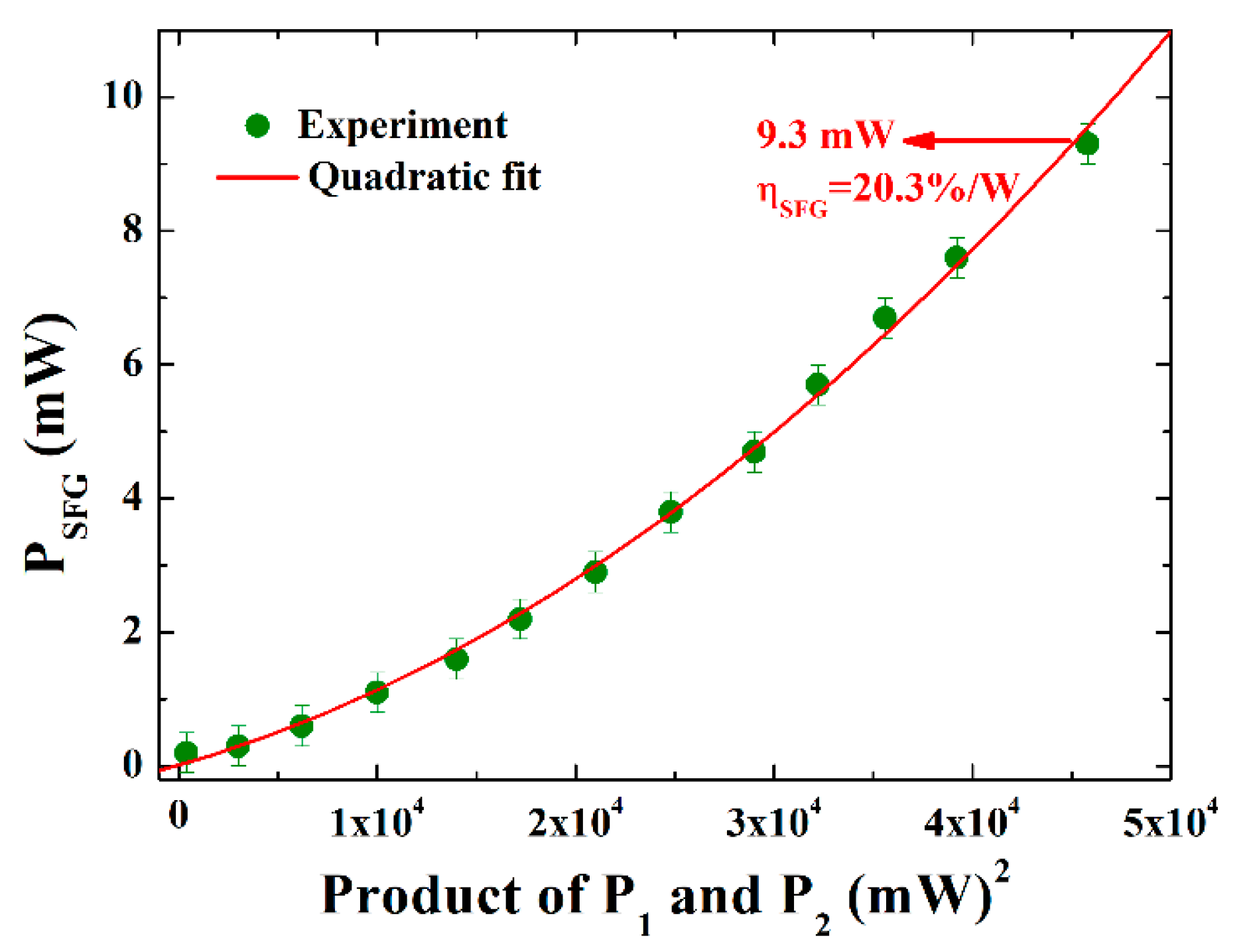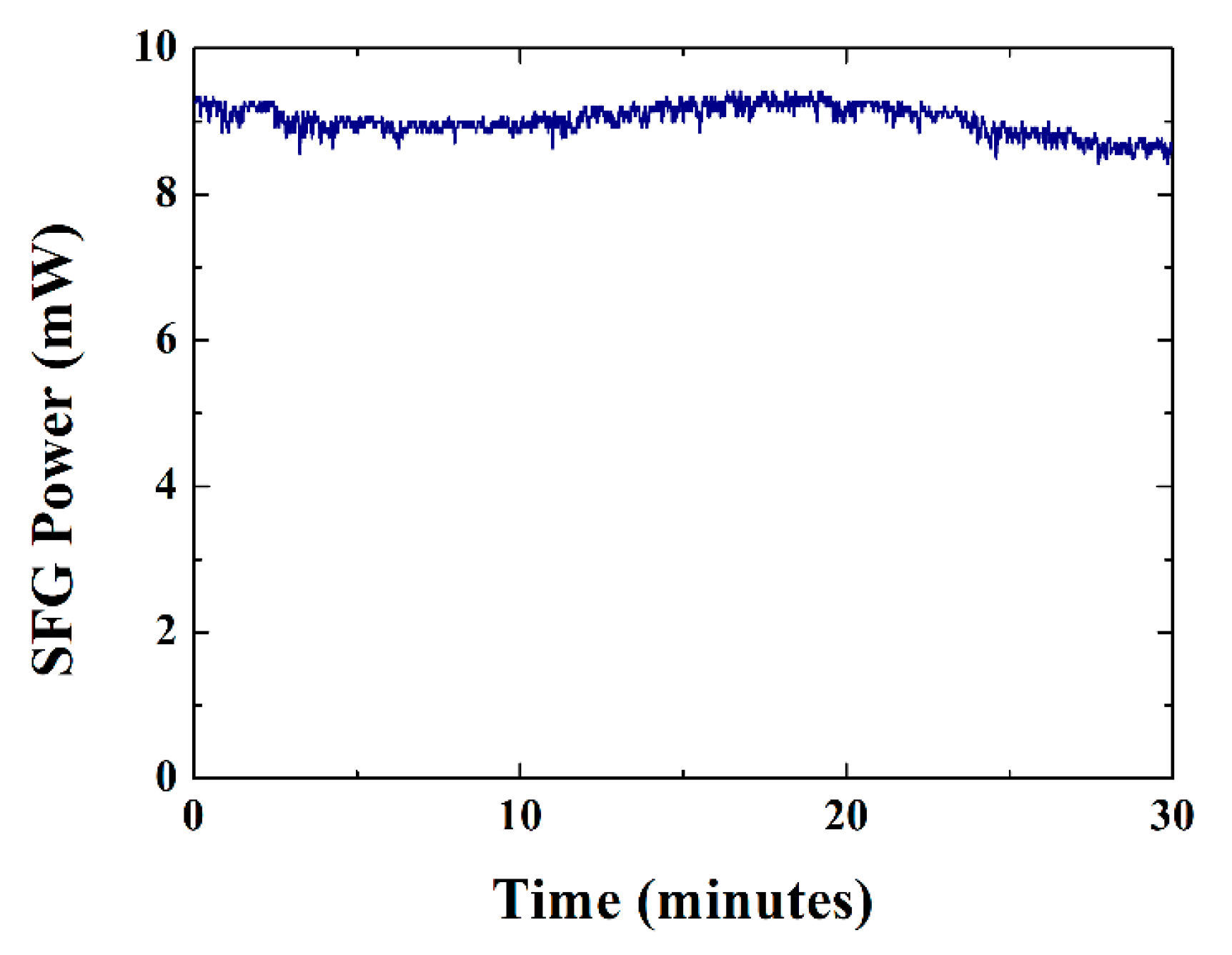Broadband and Triple-Wavelength Continuous Wave Orange Laser by Single-Pass Sum-Frequency Generation in Step-Chirped MgO:PPLN
Abstract
1. Introduction
2. Experimental Set Up
3. Results and Discussion
4. Conclusions
Author Contributions
Funding
Acknowledgments
Conflicts of Interest
References
- Karrer, S.; Bäumler, W.; Abels, C.; Hohenleutner, U.; Landthaler, M.; Szeimies, R.M. Long-Pulse Dye Laser for Photodynamic Therapy: Investigations in Vitro and in Vivo. Laser Surg. Med. 1999, 25, 51–59. [Google Scholar] [CrossRef]
- Kapoor, V.; Subach, F.V.; Kozlov, V.G.; Grudinin, A.; Verkhusha, V.V.; Telford, W.G. New Lasers for Flow Cytometry: Filling the Gaps. Nat. Meth. 2007, 49, 678–679. [Google Scholar] [CrossRef] [PubMed]
- Marzahl, D.-T.; Metz, P.W.; Kränkel, C.; Huber, G. Spectroscopy and Laser Operation of Sm3+-Doped Lithium Lutetium Tetrafluoride (LiLuF4) and Strontium Hexaaluminate (SrAl12O19). Opt. Express 2015, 23, 21118–21127. [Google Scholar] [CrossRef] [PubMed]
- Chang, W.K.; Chen, Y.H.; Chang, J.W. Pulsed Orange Generation Optimized in a Diode-Pumped Nd: YVO4 Laser Using Monolithic Dual PPLN Electro-Optic Q Switches. Opt. Lett. 2010, 35, 2687–2689. [Google Scholar] [CrossRef] [PubMed]
- Calu, D.J.; Kawa, A.B.; Marchant, N.J.; Navarre, B.M.; Henderson, M.J.; Chen, B.; Yau, H.-J.; Bossert, J.M.; Schoenbaum, G.; Deisseroth, K.; et al. Optogenetic Inhibition of Dorsal Medial Prefrontal Cortex Attenuates Stress-Induced Reinstatement of Palatable Food Seeking in Female Rats. J. Neurosci. 2013, 33, 214–226. [Google Scholar] [CrossRef] [PubMed]
- Xu, Z.Y.; Bi, Y. Large Laser Projection Displays Utilizing All-Solid-State RGB Lasers. In Proceedings of the Light-Emitting Diode Materials and Devices, Beijing, China, 12 January 2005; pp. 115–122. [Google Scholar]
- Fedorova, K.A.; Cataluna, M.A.; Battle, P.R.; Kaleva, C.M.; Krestnikov, I.L.; Livshits, D.A.; Rafailov, E.U. Orange Light Generation from a PPKTP Waveguide End Pumped by a CW Quantum-Dot Tunable Laser Diode. Appl. Phys. B Laser Opt. 2011, 103, 41–43. [Google Scholar] [CrossRef]
- Toikkanen, L.; Harkonen, A.; Lyytikainen, J.; Leinonen, T.; Laakso, A.; Tukiainen, A.; Viheriala, J.; Bister, M.; Guina, M. Optically Pumped Edge-Emitting GaAs-Based Laser with Direct Orange Emission. IEEE Photonics Technol. Lett. 2014, 26, 384–386. [Google Scholar] [CrossRef]
- Li, G.; Chen, Y.; Jiang, H.; Chen, X. Broadband Sum-Frequency Generation Using d_33 in Periodically Poled LiNbO3 Thin Film in the Telecommunications Band. Opt. Lett. 2017, 42, 939–942. [Google Scholar] [CrossRef] [PubMed]
- Lee, Y.L.; Noh, Y.; Jung, C.; Yu, T.J.; Ko, D.; Lee, J. Broadening of the Second-Harmonic Phase-Matching Bandwidth in a Temperature-Gradient-Controlled Periodically Poled Ti:LiNbO3 Channel Waveguide. Opt. Express 2003, 11, 2813–2819. [Google Scholar] [CrossRef] [PubMed]
- Kretschmann, H.M.; Heine, F.; Huber, G.; Halldórsson, T. All-Solid-State Continuous-Wave Doubly Resonant All-Intracavity Sum-Frequency Mixer. Opt. Lett. 1997, 22, 1461–1463. [Google Scholar] [CrossRef] [PubMed]
- Janousek, J.; Johansson, S.; Tidemand-Lichtenberg, P.; Wang, S.; Mortensen, J.; Buchhave, P.; Laurell, F. Efficient All Solid-State Continuous-Wave Yellow-Orange Light Source. Opt. Express 2005, 13, 1188–1192. [Google Scholar] [CrossRef] [PubMed]
- Pask, H.M.; Piper, J.A. Efficient All-Solid-State Yellow Laser Source Producing 1.2-W Average Power. Opt. Lett. 1999, 24, 1490–1492. [Google Scholar] [CrossRef] [PubMed]
- Sennaroglu, A. Broadly Tunable Continuous-Wave Solid-State Red Source Based on Intracavity-Doubled Cr4: Forsterite Laser. In Proceedings of the High-Power Lasers and Applications, San Jose, CA, USA, 22–24 January 2002; pp. 4356–4359. [Google Scholar]
- My, T.H.; Goldner, P.; Guillot-Noël, O.; Tonelli, M.; Bretenaker, F. Single-Frequency Operation of an Orange Avalanche Upconversion Laser for High-Resolution Laser Spectroscopy. Eur. Phys. J. Appl. Phys. 2004, 42, 121–124. [Google Scholar] [CrossRef]
- Majid, M.A.; Al-Jabr, A.A.; Oubei, H.M.; Alias, M.S.; Anjum, D.H.; Ng, T.K.; Ooi, B.S. First Demonstration of InGaP/InAlGaP Based Orange Laser Emitting at 608 Nm. Electron. Lett. 2015, 51, 1102–1104. [Google Scholar] [CrossRef]
- Zhu, S.N.; Zhu, Y.Y.; Ming, N.B. Quasi-Phase-Matched Third-Harmonic Generation in a Quasi-Periodic Optical Superlattice. Science 1997, 278, 843–846. [Google Scholar] [CrossRef]
- Liu, X.M.; Zhang, H.Y.; Guo, Y.L.; Li, Y.H. Optimal Design and Applications for Quasi-Phase-Matching Three-Wave Mixing. IEEE J. Quantum Electron. 2002, 38, 1225–1233. [Google Scholar]
- Charbonneau-Lefort, M.; Fejer, M.M.; Afeyan, B. Tandem Chirped Quasi-Phase-Matching Grating Optical Parametric Amplifier Design for Simultaneous Group Delay and Gain Control. Opt. Lett. 2005, 30, 634–636. [Google Scholar] [CrossRef] [PubMed]
- Umeki, T.; Asobe, M.; Yanagawa, T.; Tadanaga, O.; Nishida, Y.; Magari, K.; Suzuki, H. Broadband Wavelength Conversion Based on Apodized χ2 Grating. J. Opt. Soc. Am. B 2009, 26, 2315–2322. [Google Scholar] [CrossRef]
- Tehranchi, A.; Kashyap, R. Design of Novel Unapodized and Apodized Step-Chirped Quasi-Phase Matched Gratings for Broadband Frequency Converters Based on Second-Harmonic Generation. J. Lightw. Technol. 2008, 26, 343–349. [Google Scholar] [CrossRef]
- Zeng, X.L.; Ashihara, S.; Wang, Z.J.; Wang, T.Y.; Chen, Y.P.; Cha, M. Excitation of Two-Colored Temporal Solitons in a Segmented Quasi-Phase-Matching Structure. Opt. Express 2009, 17, 16877–16884. [Google Scholar] [CrossRef] [PubMed]
- Bostani, A.; Tehranchi, A.; Kashyap, R. Super-Tunable, Broadband up- Conversion of a High-Power CW Laser in an Engineered Nonlinear Crystal. Sci. Rep. 2017, 7, 883. [Google Scholar] [CrossRef] [PubMed]
- Pan, S.D.; Yu, X.Q.; Yan, Z.; Shen, Y.; Lv, X.J.; Zhu, S.N. Efficient Generation of Orange Light in a Quasi-Periodically Poled LiTaO3 Crystal. Appl. Phys. B Lasers Opt. 2008, 93, 749–752. [Google Scholar] [CrossRef]
- Mieth, S.; Henderson, A.; Halfmann, T. Tunable, Continuous-Wave Optical Parametric Oscillator with More than 1W Output Power in the Orange Visible Spectrum. Opt. Express 2014, 22, 11182–11191. [Google Scholar] [CrossRef] [PubMed]
- Bisson, S.E.; Armstrong, K.M.; Kulp, T.J.; Hartings, M. Broadly Tunable, Mode-Hop-Tuned CW Optical Parametric Oscillator Based on Periodically Poled Lithium Niobate. Appl. Opt. 2001, 40, 6049–6055. [Google Scholar] [CrossRef] [PubMed]
- Chen, B.Q.; Ren, M.L.; Liu, R.J.; Zhang, C.; Sheng, Y.; Ma, B.Q.; Li, Z.Y. Simultaneous Broadband Generation of Second and Third Harmonics from Chirped Nonlinear Photonic Crystals. Light Sci. Appl. 2014, 3, 1–6. [Google Scholar] [CrossRef]
- Gayer, O.; Sacks, Z.; Galun, E.; Arie, A. Temperature and Wavelength Dependent Refractive Index Equations for MgO-Doped Congruent and Stoichiometric LiNbO3. Appl. Phys. B Lasers Opt. 2008, 91, 343–348. [Google Scholar] [CrossRef]
- Powers, P.E. Field Guide to Nonlinear Optics; Greivenkamp, J.E., Ed.; SPIE: Bellingham, WA, USA, 2013. [Google Scholar]





© 2018 by the authors. Licensee MDPI, Basel, Switzerland. This article is an open access article distributed under the terms and conditions of the Creative Commons Attribution (CC BY) license (http://creativecommons.org/licenses/by/4.0/).
Share and Cite
Li, G.; Choge, D.K.; Chen, H.; Xu, Y.; Guo, L.; Liang, W. Broadband and Triple-Wavelength Continuous Wave Orange Laser by Single-Pass Sum-Frequency Generation in Step-Chirped MgO:PPLN. Appl. Sci. 2018, 8, 1657. https://doi.org/10.3390/app8091657
Li G, Choge DK, Chen H, Xu Y, Guo L, Liang W. Broadband and Triple-Wavelength Continuous Wave Orange Laser by Single-Pass Sum-Frequency Generation in Step-Chirped MgO:PPLN. Applied Sciences. 2018; 8(9):1657. https://doi.org/10.3390/app8091657
Chicago/Turabian StyleLi, Guangwei, Dismas K. Choge, Huaixi Chen, Yibin Xu, Lei Guo, and Wanguo Liang. 2018. "Broadband and Triple-Wavelength Continuous Wave Orange Laser by Single-Pass Sum-Frequency Generation in Step-Chirped MgO:PPLN" Applied Sciences 8, no. 9: 1657. https://doi.org/10.3390/app8091657
APA StyleLi, G., Choge, D. K., Chen, H., Xu, Y., Guo, L., & Liang, W. (2018). Broadband and Triple-Wavelength Continuous Wave Orange Laser by Single-Pass Sum-Frequency Generation in Step-Chirped MgO:PPLN. Applied Sciences, 8(9), 1657. https://doi.org/10.3390/app8091657





